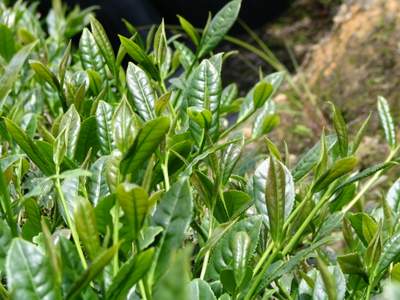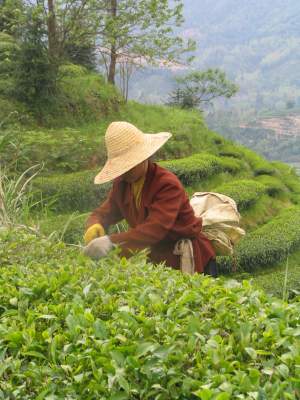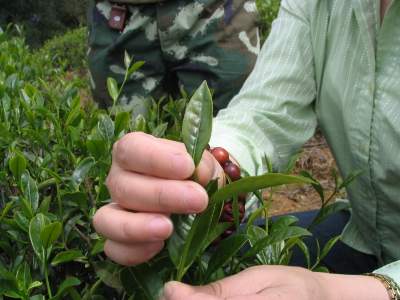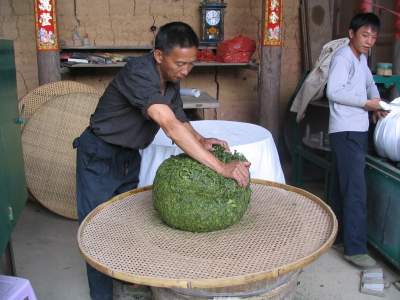What is Oolong?
Oolong tea
The most sophisticated of all tea types
For tea enthusiasts, Oolong is perhaps the most sought-after of all tea types. Oolong teas are highly diverse. Each tea has its unique leaf and color nuance. Oolong teas are oxidized from 10 to 80 percent. During the production phase, Oolong teas undergo repeated roasting, and each type has a different production process related to the area in which it is grown.
Adding to this is the tea master’s own ‘interpretation’ of the tea, resulting in the diversity of flavors and appearances that are so characteristic of Oolong tea. In other words, it is a tea that offers a wide spectrum of aromas and sophisticated, refined flavors. Oolong can have complex notes of nuts, flowers, butter, chocolate, and burnt sugar.
Origin
Oolong tea originally comes from China, and the best varieties can be found in the southeastern provinces of Fujian and Guangdong. Fujian is a treasure trove of fantastic and exquisite teas, such as Bai Hou Yin Zhen, Lapsang Bohea, Keemun Sunrise, and Jin Junmei, in addition to the many superb Oolong teas from the region.
In northern Fujian lie the Wu Yi mountains, which have given their name to the so-called Rock Oolong teas, which have always been highly sought after. The Wu Yi mountain area is a picturesque region with rivers, bamboo forests, and spectacular mountain formations formed from the local limestone.
The mineral and iron-rich red clay soil in which the tea trees and bushes are planted on the mountain slopes or ridges imparts unique mineral flavor nuances, which is part of what makes Rock Oolong teas so special.
The highest and most inaccessible mountain ridges are home to the most sought-after and expensive teas in this treasure trove of China. Many of the bushes are over 50 years old and yield only a limited harvest each year in April and May, making them rare and desirable.
It is from this area that Simply Tea sources Da Hong Pao (Big Red Robe Oolong), Rou Gui, and Tie Luo Han teas.
The teas from this region are truly exceptional, which is why the best of these teas rarely leave China. Unlike in Denmark, where we export our best quality bacon abroad, the Chinese keep the finest batches of tea for themselves. They go to party and government leaders and as gifts to foreign heads of state.
Other superb Rock Oolong teas from the Wu Yi mountains include: Qian Li Xian – the Eight Immortals and Shui Xian – Phoenix Narcissus.
In southern Fujian, tea terraces are almost carved into the mountainsides around the city of Anxi. The area is close to the coast with a subtropical climate and rich, fertile soil, which is perfect for the Guan Yin bush, from which the famous Tie Guan Yin (Goddess of Mercy) is cultivated.
Tie Guan Yin
Tie Guan Yin is produced in more than 27 villages in Anxi. Most commercial Anxi teas are grown at an altitude of 400 meters. However, Simply Tea’s High Mountain Oolong and Golden Guan Yin are grown far from urban and industrial areas at about 800 meters. The altitude means that the area is protected from the sun’s burning rays by a thin layer of mist. The result is a tea rich in amino acids with a complex aroma and a hint of citrus.
The tea master carefully ensures that the leaves of Tie Guan Yin remain as whole as possible; this creates a clear and even flavor that does not become bitter. This is a very special tea made exclusively from leaves of Tie Guan Yin.
Packed in Cotton Bags and Rolled
Anxi Oolong teas undergo a very special rolling process. About halfway through the process, the leaves are packed into a cloth bag and tightened into a hard ball. The ball is placed in a machine that very gently rolls the leaves, after which the leaves are loosened, and the process is repeated about 16 times. The purpose is to give the tea its familiar half-round shape and to activate the juices in the leaves, which is what imparts a special floral aroma and flavor to the tea.
Dan Cong
In the northeastern area of Guangdong Province, near the city of Chaozhou, there are five mountain peaks that belong to the Phoenix Mountains. The mountains are famous for a unique Oolong tea that competes with Wu Yi Shan Rock Oolong, namely Feng Huang Dan Cong. Dan Cong is harvested from old, wild, large-leaved trees that grow at an altitude of 1400 meters in the Phoenix Mountains.
Some of the trees are over 700 years old. They are picked once at the end of April or the beginning of May, depending on the weather. In appearance, Dan Cong and Rock Oolong are very similar, as the leaves from both types are twisted, giving them a shape reminiscent of dragon figures.
Health and Oolong Tea
In recent years, Oolong teas have gained attention in the West due to the current focus and research on obesity and weight loss. In China, it has been known for centuries that the darker and more oxidized Oolong teas can aid digestion, cure headaches, and detoxify the body after excessive intake of toxins such as cigarettes and alcohol. However, despite the research, there is no conclusive evidence that they actually lead to weight loss.
One should therefore be cautious of unscrupulous vendors who use weight loss claims to disguise their attempts to sell low-quality tea. And it should be remembered – as is the case with all teas – that the primary focus is on the tasting experience of drinking tea. The health benefits are, so to speak, the icing on the cake.
Nevertheless, the physiological relief from drinking Oolong can be quite apparent if one consumes certain teas (especially Dan Cong tea!) after a heavy meal. It can have a soothing effect on the stomach, and since Oolong tea acts as a counterbalance to rich or fatty foods, we often recommend it with cheese or cream cakes.
Rock Oolong tea also releases nutrients from the mineral-rich soil of the Wu Yi mountains, which is believed to benefit health and has a soothing effect on joint and muscle pain. At the other end of the Oolong spectrum, we find Anxi Oolong, a lightly oxidized tea that is very popular and sought after in Japan, as it is particularly regarded as protective for the liver.
Tips for Assessing Oolong Quality
The best qualities of Oolong tea never become bitter, regardless of how long they are allowed to brew. However, certain good Dan Cong Oolong teas may have a slight bitterness, but this is a sought-after tasting experience for the tea, especially among the locals. The best Dan Cong Oolong teas are sweeter and smoother in flavor. They maintain their rich flavor through multiple brews and leave a delightful long aftertaste.
For Anxi and Dan Cong Oolong, it is important that most leaves are not damaged but remain whole when the tea is fully brewed. Since Rock Oolong undergoes more roasting stages than Dan Cong Oolong, these leaves are expected to be slightly more fragile and typically not as ‘whole’ as Dan Cong leaves.
When the tea is brewed, the leaves should be fresh, flexible, and juicy. They should not be tough, old, or thick, which would indicate that they were harvested too late.
The name Oolong comes from Wu Long. Wu comes from Wu Yi Shan (shan means mountain), and Long means dragon. It is Europeans who have renamed Wu Long to Oolong.
If you want to learn more about the sophisticated Oolong teas, you can sign up for one of our tea tasting courses on Oolong tea here.
Dan Cong tea comes from Dan Cong tea trees. In normal tea bushes, the trunk consists of several stems that grow together from the roots. In contrast, Dan Cong tea trees grow with a single trunk. These differences are also reflected in the flavor of the tea.




